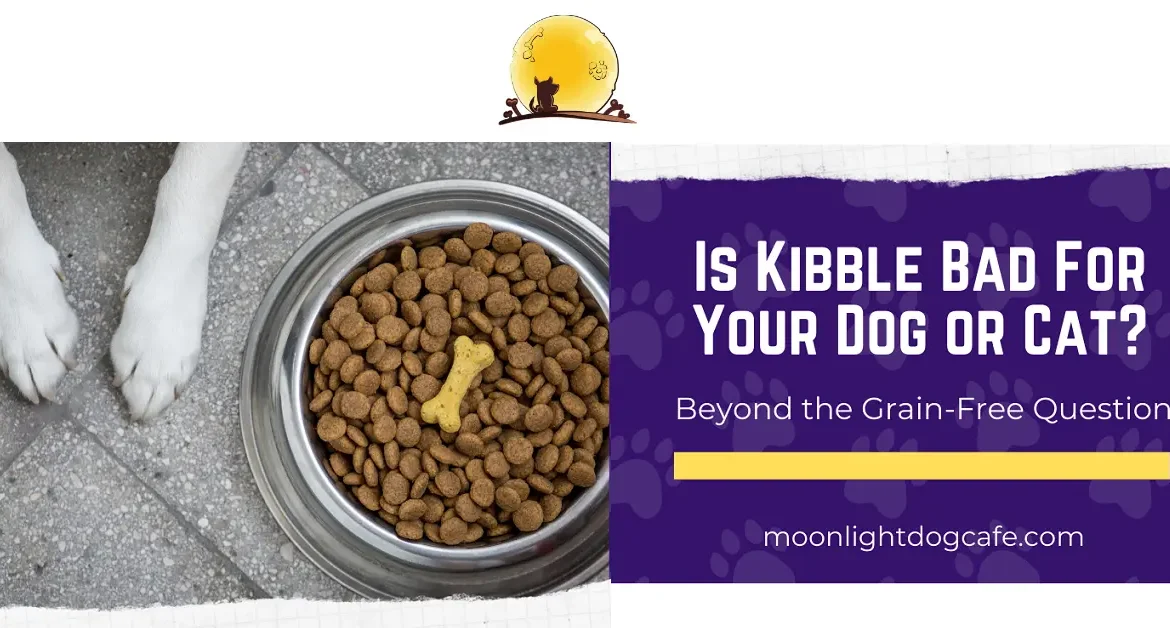
Pet Kibble Explained: Ingredients, Risks & Better Alternatives
Understanding Pet Kibble: Composition and Ingredients
Pet kibble food are little dry ‘biscuits’ of dog /cat food made using carbohydrate, meat, sprayed with fat and in most cases, supplemented with synthetic vitamins. Typically grains or in the no-grain formulas potatoes are used as the carbohydrate. In this blog, we will continue our blog series on how to choose pet food and what should be in your dog or cat’s food.
The Evolution of Pet Kibble: A Historical Perspective
Kibble is relatively new in terms of feeding pets. James Spratt launched the first commercial dog biscuit around the 1860s.
The story states that he saw a ship that had docked in England from the US throw stale biscuits overboard. The hungry dogs of the day ate these biscuits with gusto and consequently, an industry was born.
The convenience of dog kibble was above all marketed to pet owners. The main motive of the industry was to sell a product. That motive however has not changed since James Spratt launched kibble. Pet food represented a way for large companies to sell by-products of human consumption to pets.
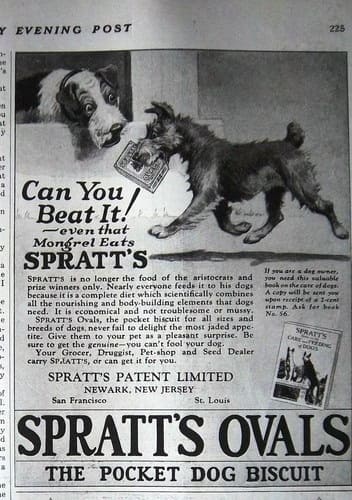
Pet Kibble Market Trends: Current Sales and Statistics
In 2017, according to Statista, sales of the leading dry dog food accounted for billions of dollars in the USA with private labels at around $769 billion while Pedigree Petfoods, Purina and Iams raked in hefty sales of over $100 million in different lines of pet food.
Furthermore, the sales of the leading dry cat food kibble brands in 2017 in the USA is also about another billion dollars.
I am not suggesting that there is anything wrong with the motive of making money. The profit motive will need to be balanced against above all with a ‘do no harm to the dogs and cats.’ However, I’m not sure that is the case.
The Kibble Manufacturing Process: How Dog and Cat Food is Made
Pet food kibble is commonly made through a process called extrusion. Firstly, extrusion takes a combination of raw and wet ingredients to make a dough. Here are the steps to making kibble pet food:
- The dough is fed through extreme heat and/or steam and then forced through an extruder at high heat and pressure.
- At this point, the cooked dough is cut into tiny ‘kibbles’ at the end of the extruder, which has different shaped die holes.
- The pet food kibble is then put through a drying oven, which removes the remaining moisture.
- The kibble is cooled and then sprayed with fats, oils, minerals and vitamins.
- The pet food is sealed quickly before the fats and oils react with the air to go rancid.
The major consistent element in the process of making kibble is heat (See Step 1 to 3 above) and to a lesser extent pressure. This will be important when we talk about nutrition needs.
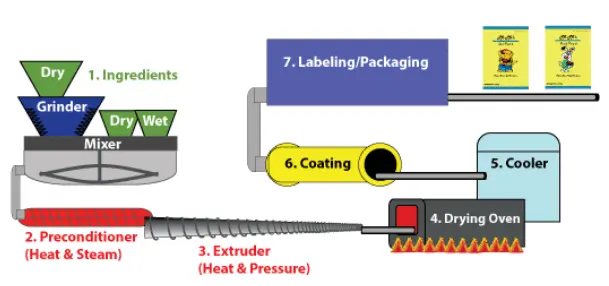
Schematic of how pet food is made from manufacturer of equipment.
AAFCO’s Role in Pet Food Regulation and Standards
This topic requires a whole other blog. Here are the important things to remember.
- The AAFCO Nutrient Profiles is held as the ‘gold’ standard for how pet food should be made. If things do not meet AAFCO standards, pet foods are generally not considered complete or balanced. This often makes consumers think that they are the regulatory body.
- However, despite the fact that there is a standard, it falls short. The FDA itself stated in 2014 that “the AAFCO process ultimately falls short” and “the majority of ingredients that are included in the AAFCO ‘official publication’ are neither approved food additives nor are they generally recognized as safe (GRAS).
We’ll write a blog on how the AAFCO process works at a later date.
Here is what we “know” about canine/ feline nutrition:
- Dogs and Cats need good biologically-available protein. The necessary amino acids that pets need from pet food are:
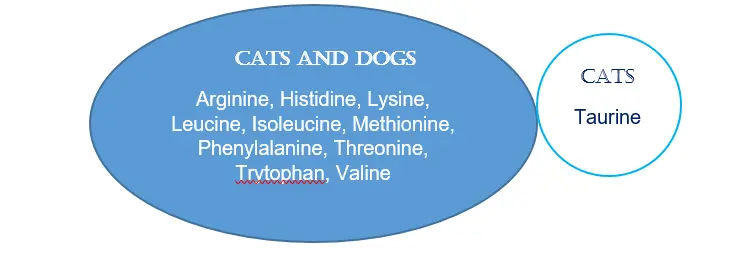 The best sources of all these amino acids for dogs & cats tend to be meat, animal organs & in some cases fish.
The best sources of all these amino acids for dogs & cats tend to be meat, animal organs & in some cases fish. - Dogs and Cats need Fats, which is rich in energy and provides the essential fatty acids (omega 3 and omega 6s). Common sources tend to be flaxseed oils and fish/krill oils.
- Vitamins and minerals in food are essential for life.
- Fat soluble Vitamins – (Vitamin A,D, E and K) which can accumulate in the body and become toxic.
- Water soluble Vitamins – (Vitamin C and the B vitamins i.e. thiamin, riboflavin, niacin, pantothenic acid, pyridoxine, biotin, folic acid, cobalamin)
- Minerals are the inorganic component of the diet, which are necessary for bones, blood, skin and other important functions.
- Dogs and cats need an adequate source of water/moisture.
- Guaranteed probiotics and enzymes.
- Carbohydrates are not necessary, a cheap source of energy and potentially more harmful to cats.
Kibble vs. Essential Nutrients: Assessing Its Impact on Pet Health
When raw food proponents are asked why not kibble, they usually point to pet food nutrition loss due to cooking. Let’s evaluate the effect of heat on the building blocks above.
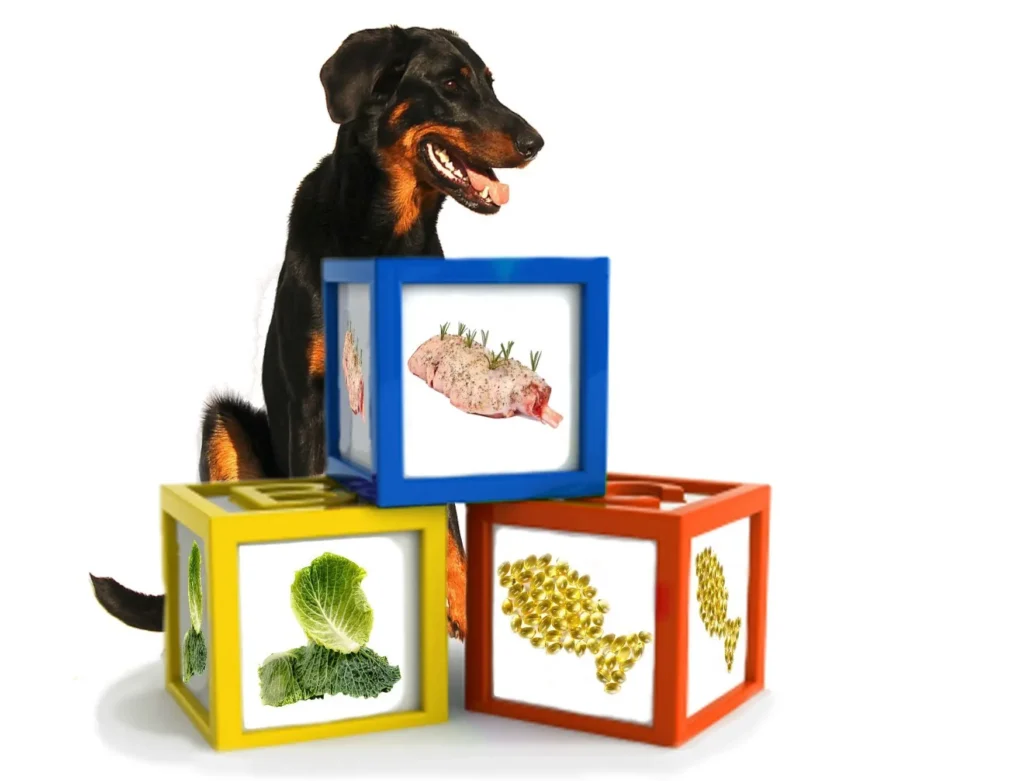
Heat Processing in Kibble Production: Nutrient Loss in Canine and Feline Diets
Proteins change when heated. Any form of cooking denatures the protein, which means that it alters the protein usually into the peptide subunits. At high enough temperatures, peptides can also be destroyed. “Drying can significantly affect the nutrient content of pet foods. At high drying temperatures (160–200◦ C), lysine damage occurs with reactive lysine decreasing faster compared to total lysine. No other amino acids were affected by drying temperature in the present study except for proline in the 4 mm kibbles, which was increased by drying temperature of 200 ◦C.” (1) This is usually one of the main reasons that raw food proponents cite for feeding raw pet food.
USDA Findings on Nutrient Retention: Counterpoints to Kibble Nutrient Loss?
To counter this argument about food nutrition loss, kibble experts likewise point to a US Department of Agriculture (USDA) study. The 2007 USDA retention of nutrients showed that common cooked proteins like beef and chicken retained their nutrients pretty well. (2) What was clear was some reduction in Vitamin A, B, C with Calcium, Iron, Magnesium and Phosphorus not much changed.
However, when Beef was ground and then baked without drippings, the nutrient loss was higher than when whole and roasted.
- The ground meat seemed to lose more nutrients easily than whole meat. This may be important as the process of making kibble requires mixing ground meat with dry ingredients. Unfortunately, the study did not evaluate a whole protein vs ground and put through the same heating process.
- The temperatures used in the USDA study were not stated.
Although the USDA study provides nutritional loss context, it is unclear whether this nutrient loss negatively impacts dogs and cats. Kibble manufacturers will state that these nutrients are put back in the form of synthetic vitamins/ingredients. Raw food proponents will counter that we do not know enough about canine/feline nutrition.
Pet Kibble Nutrition: Essential Facts Every Owner Should Know
Nutritional Impact of Cooking: Understanding Losses in Kibble Preparation
- Cooking denatures protein and there will be nutritional losses in canine and feline kibble diets for Vitamins and minerals.
- The process of making kibble requires mixing ground meat with dry ingredients. The nutritional loss from cooking ground meat seems higher than whole meat.
Effects of High-Temperature Processing on Lysine and Taurine in Pet Diets
- High temperatures in cooking affect Lysine, an amino acid which is critical “for the synthesis of all proteins.” (3)
- “Lysine is often the first limiting amino acid in the diet, which means it has the greatest risk of being deficient if a pet food is not carefully formulated.” (3)
- A 2006 research paper published in the Journal of Nutrition concluded that “Damage to lysine in canine diets, most likely by factors such as the use of ingredients containing damaged lysine (e.g., corn, wheat), extrusion, and/or storage, appears to be significant and varies greatly between brands. Although the total lysine content may be sufficient to meet lysine requirements for growth and maintenance, a large proportion of the lysine in the diets appears to have been damaged and can be expected to be unavailable to dogs” (4)
- High temperatures also result in Taurine deficiency that was fatal for thousands of cats in the 1980s and may be causing heart issues (dilated cardiomyopathy or DCM) in both cats and dogs. Raw food proponents also cite the taurine issue to show the vet and kibble community do not fully understand canine/feline nutrition.
- A paper published in the Journal of the American Veterinary Medical Association, concluded that taurine deficiency in dogs were through consumption of certain commercial diets and led to dilated cardiomyopathy. “Results suggest that consumption of certain commercial diets may be associated with low blood or plasma taurine concentrations and DCM in dogs.” (5)
Impact of Heat on Fatty Acids and Enzymes in Pet Kibble
- Heat has a huge impact on decreasing fatty acids. “In addition to amino acids, most unsaturated long-chain fatty acids were observed to be decreased in the 4 and 8 mm kibble dried at 200 ◦C.” (1)
- Also there may be an effect on enzymes. Based on research, there is some indication some enzymes do better below 150 C.
Salmonella Concerns in Pet Food: FDA Guidelines and Manufacturer Practices
- The FDA and USDA puts heavy pressure on pet food manufacturers to ensure there is no Salmonella or E coli. This invariably means high temperatures are likely used to cook pet food. According to a 2013 FDA Guidance on Salmonella in Food for Animals, “FDA believes regulatory action is warranted in cases involving pet foods contaminated with any Salmonella serotype, due to the heightened human health risk given the high likelihood of direct human contact with such food. ” (6)
- Pet food manufacturers guard heat processing information as that may tell the public whether the peptides are destroyed or intact.
- Salmonella and E coli are still a problem in pet food kibble. A 2010 paper found “reducing water activity either by desiccation or by addition of solutes resulted in increased thermal tolerance.” (7) This means that Salmonella might be tougher and persist in dry pet food kibble.
- Note that the FDA guidance is focused on the effects of salmonella primarily on humans not the animal.
Ingredient Selection in Kibble Production: What Manufacturers Choose
- Kibble pet food manufacturers make an effort to add back any “known” nutritional losses. This is either in the form of synthetic vitamins, minerals and taurine.
- Despite these efforts, there are issues of contamination and poisoning. An example was in the Melamine issue, where it was added as to simulate higher protein content. (8)
- There are also issues of too much vitamins / minerals causing adverse pet health issues. Recently, there was the Vitamin D Toxicity issue. A 2018 study showed that ultra-trace minerals were way above “average human daily consumption on a caloric basis” but may be safe in dry dog foods.
- The FDA stated that “the majority of ingredients that are included in the AAFCO ‘official publication’ are neither approved food additives nor are they generally recognized as safe (GRAS).”
- Some pet food manufacturer use already rendered under high heat and nutritionally low ingredients but still can pass feeding trials. The long-term effect on cats and dogs would be harmful.
Carbohydrates in Kibble: Necessity and Potential Health Implications
- Carbohydrate, which is not necessary for dogs and cats nutrition is necessary to bind the ingredients in pet kibble.
- Most carbohydrates tend to be grains, with purported food intolerance by both dogs and cats leading to diarrhea etc. Note that I’m not adding supposed allergy issues because that is controversial.
- “Mycotoxins contaminate cereal grains worldwide, and their presence in pet food has been a potential health threat to companion animals. ” (9) However, a lot of the big dry pet food manufacturers are adamant about using grains.
- Heart issues /DCM is now associated with grain-free diets, which use potatoes, chickpeas or lentils.
- The ratio of protein to carbohydrates in a dog’s or cat’s gut have an impact on the gut bacterial balance and the potential for fighting bacteria &/ or viruses. (10)
- “Since the cat’s diet in the wild contains almost nothing in the way of carbohydrates (which are simple sugars). They either never had the gene for sweet-detecting, or they lost it somewhere down the evolutionary road.”
Enhancing Kibble Palatability: The Role of Fats and Flavors As Well as Risks
- Dogs and cats do not like the cooked kibble without the spraying of fats and flavour to make it palatable.
- “To meet nutritional requirements, pet food manufacturers blend animal fats and meals with soy and wheat grains and vitamins and minerals. This yields a cheap, nutritious pellet that no one wants to eat. Cats and dogs are not grain eaters by choice, Moeller is saying.” (Popular Science – The Chemistry of Kibble)
- To entice cats to eat the extruded kibble, some pet food manufacturers use pyrophosphates, which are considered “kitty crack.”
- It is not understood why cats like the taste of pyrophosphates eg. tetrasodium pyrophosphate. However, here is what the US National Library of Medicine has on tetrasodium pyrophosphate:
- “HUMAN EXPOSURE AND TOXICITY: Alkaline and irritating. Nausea, vomiting and diarrhea are probable after ingestion. Medical reports of acute exposures show mild to moderate dermal and ocular responses.
- ANIMAL STUDIES: Tetrasodium pyrophosphate when added to the diets of rats in high concentrations it caused kidney damage. This chemical caused teratogenic effects in chicken embryos. Acute studies show that direct contact causes severe irritation and corneal injury in the rabbit eye and that it may be irritating to skin. This chemical can be considered moderately toxic on ingestion, inducing metabolic acidosis, and hypocalcemia.”
Veterinary Recommendations for Kibble: Evaluating Safety and Nutritional Value
Conspiracy aside, there is truth that-
- Dry pet food companies and pharmaceutical companies do sponsor veterinary schools and the vet associations.
- There are job opportunities/ revolving doors to the dry pet food companies like Purina, Hills Science Diet as well as pharmaceutical companies.
- Some dry food companies are buying veterinary clinics e.g. VCA hospitals are now part of MARS Pet care, which makes some of the junkiest pet foods. In their own words, “Mars Petcare has been in operation for more than 75 years and now includes three of the top five pet food brands in the world – PEDIGREE, WHISKAS and ROYAL CANIN. Mars Petcare is also home to the brands NUTRO, GREENIES, SHEBA, CESAR, IAMS AND EUKANUBA. Mars Petcare is the world’s biggest veterinary health group with hospitals such as BANFIELD, BLUE PEARL, PET PARTNERS, and VCA .“
Examining Potential Biases in Veterinary Pet Food Research
Governments are not sponsoring or funding pet-based research projects. Several vets online deny the potential for bias in research because they are trained not to be biased. However, with all the reasons stated, it would be remiss to not note that the bias could already be systemic.
If research funding sources are limited, it is likely that a research vet will choose certain questions, which preclude other avenues of thought. It is not an assertion that vets fudge research because that is unethical. In addition, if a vet clinic as an employer suggests dry food, any vet working there would not go against the vet clinic’s suggestions. It is like working for an Apple Store but suggesting a Blackberry to a customer. Not accepted practice.
Balancing Veterinary Nutritional Advice and Personal Choices
I think it is easy to dismiss the vet community as being probably in bed with pet food and pharmaceutical companies. There are many news articles of pharmaceutical company reps showing partial research and pushing certain drugs for humans to the detriment of consumers. The same has been said to happen in the vet industry. See one such article from here.
The truth is that a lot of advances in care of small animal companions are made because research vets get money from these companies. I for one am grateful for the skills vets have developed in surgery on our small animal companions. However, it is up to each pet parent to make informed decisions about what our pets eat.
Click here to read an analysis on the best and worst dog kibble after reviewing over 90 kibble formulations and 50+ kibble brands.
Being informed means not leaving the feeding decision to a seeming expert but rather asking tough, logical questions.
References
- Q.D. Tran, W.H. Hendriks, A.F.B. van der Poel (2011). Effects of drying temperature and time of a canine diet extruded with a 4 or 8 mm die on physical and nutritional quality indicators.
- 2007 USDA retention of nutrients table
- Waltham Pocket book of essential nutrition for cats and dogs
- Pamela A. Williams, Suzanne M. Hodgkinson, Shane M. Rutherfurd, and Wouter H. Hendriksz. (2006) Lysine Content in Canine Diets Can Be Severely Heat Damaged. (The Journal of Nutrition, Volume 136, Issue 7, 1 July 2006, Pages 1998S–2000S)
- Andrea J. Fascetti, VMD, PhD, DACVN, DACVIM John R. Reed, DVM, MS, DACVIM Quinton R. Rogers, PhD, DACVN Robert C. Backus, DVM, PhD. (2003) Taurine deficiency in dogs with dilated cardiomyopathy: 12 cases (1997–2001) Journal of the American Veterinary Medical Association October 15, 2003, Vol. 223, No. 8, Pages 1137-1141
- FDA Compliance Policy Guide Sec. 690.800 Salmonella in Food for Animals
- Nadia Gruzdev, Riky Pinto, and Shlomo Sela (2010). Effect of Desiccation on Tolerance of Salmonella enterica to Multiple Stresses
- Cianciolo RE, Bischoff K, Ebel JG, Van Winkle TJ, Goldstein RE, Serfilippi LM (September 2008). “Clinicopathologic, histologic, and toxicologic findings in 70 cats inadvertently exposed to pet food contaminated with melamine and cyanuric acid”. Journal of the American Veterinary Medical Association. 233 (5): 729–37
- Maxwell C. K. Leung, Gabriel Díaz-Llano, and Trevor K. Smith (2006). Mycotoxins in Pet Food: A Review on Worldwide Prevalence and Preventative Strategies
- Qinghong Li, Christian L. Lauber, Gail Czarnecki-Maulden, Yuanlong Pan and Steven S. Hannah. Effects of the Dietary Protein and Carbohydrate Ratio on Gut Microbiomes in Dogs of Different Body Conditions. mBio (2017) vol. 8, no. 1, e01703-16, doi: 10.1128/mBio.01703-16
- H Hendriks, W & M. A. Emmens, M & Trass, B & Pluske, John. (1999). Heat Processing Changes the Protein Quality of Canned Cat Foods as Measured with a Rat Bioassay. Journal of animal science. 77. 669-76. 10.2527/1999.773669x.
- Sales of the leading dry dog food brands in the United States in 2017 (in million U.S. dollars) https://www.statista.com/statistics/586507/sales-dry-dog-food-brands-in-the-united-states/



[…] It is probably more likely to get listeria/ salmonella from kibble because owners do not wash their hands after touching it. This is because most pet owners assume incorrectly that as kibble was cooked it protects them from listeria, salmonella or e coli. Contamination typically happens in the kibble manufacturing process after cooking. See here for information on kibble manufacturing. […]
[…] here for a discussion on nutrient loss when food is […]
[…] Beyond grain-free pet kibble; Is kibble bad for your dog & cat?- (PART 1) […]